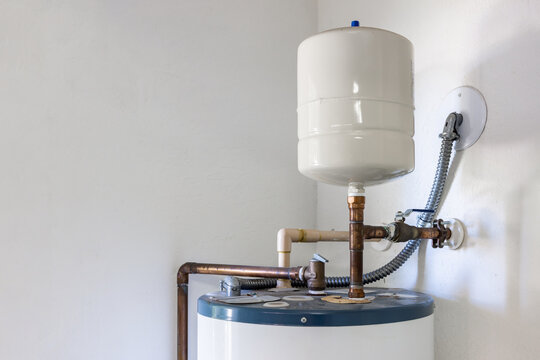
You probably don’t spend much time thinking about water pressure until something goes wrong. A banging pipe, a leaky water heater, or a worn-out valve often points to a problem with pressure buildup inside your plumbing system. That’s where an expansion tank comes in. In this guide, we’ll break down the purpose and function of expansion tanks, how they protect your plumbing and water heater, and the warning signs that yours may need attention.
What Is an Expansion Tank?
An expansion tank is a small, cylindrical container usually installed near your water heater. It absorbs excess pressure caused by thermal expansion, which happens when water heats up and expands inside a closed plumbing system. Inside the expansion tank is a flexible divider that splits the tank into two chambers. One side contains air under pressure while the other connects to your water line and absorbs expanding hot water.
When your water heater heats water, it expands in volume. In a closed system, that expanding water has nowhere to go. Without a buffer, such as an expansion tank, the pressure can force its way through your pipes, causing excessive wear, leaks, and damage.
Why Thermal Expansion Is an Issue
Water expands when heated, and that expansion generates additional pressure in the plumbing system. For example, a 50-gallon water heater can increase in volume by almost half a gallon as the water heats from 50°F to 120°F. In a closed system, this extra volume compresses against the walls of your pipes and fixtures. Even if the pressure spike only lasts a few seconds, those repeated surges over time can stress your water heater tank.
Eventually, the temperature and pressure (T&P) relief valve will leak. It can also harm shut-off valves or flexible supply lines. This will shorten the lifespan of water-consuming appliances, such as dishwashers and washing machines. When you have an expansion tank in your home, it acts like a pressure relief cushion, keeping pressure levels within a safe range.
How Expansion Tanks Work
As your water heater runs and heats the water, the water expands during the process. With an expansion tank, the additional volume pushes into the tank. The air cushion inside the tank compresses, absorbing the pressure spike. Then, as the water cools and contracts, the pressure equalizes and the expansion tank resets.
This continuous process protects your entire plumbing system by maintaining more consistent water pressure. It also prevents stress-related failures and helps extend the life span of your water heater and fixtures.
Do You Need an Expansion Tank in Your Home?
Many building codes now require expansion tanks on closed systems, especially when a pressure-reducing valve (PRV) or backflow preventer is present. Without one, there’s a risk of creating dangerously high pressure in the system.
You likely need an expansion tank if:
- You have a closed plumbing system with a backflow preventer.
- Your water heater’s relief valve is leaking.
- You hear banging pipes.
- You have high water pressure.
- Your water heater is less than 10 years old.
Even if it’s not a legal requirement in your area, installing an expansion tank is a smart move if you’re upgrading your water heater or dealing with repeated pressure-related plumbing issue.
Choosing the Right Size of Expansion Tank
The size of the tank depends on your water heater’s capacity and the system pressure. A 40-to-60-gallon water heater usually pairs well with a 2-gallon expansion tank. If the tank is too small, it won’t be effective. If it’s too large, it may not operate efficiently. That’s why it’s best to have one of our licensed plumbers at GEM Plumbing & Heating inspect your setup and recommend the correct tank size based on our expertise and knowledge of local building codes.
Maintenance Tips
Expansion tanks are relatively low-maintenance, but periodic inspections ensure optimal performance and prevent potential issues. During an inspection, we always check for corrosion or leaks. We test the air pressure in the air chamber to make sure it matches your home’s water pressure. We also watch for leaking T&P valves, noisy pipes, or fluctuating water pressure as these may signal that the tank is failing.
Contact GEM Plumbing & Heating
Expansion tanks may be small, but their role in maintaining an efficient plumbing system is huge. It’s a straightforward upgrade that safeguards your investment and ensures your water system operates efficiently. We are a family-owned business proudly serving the Greater Providence area for over 75 years. If you’re installing a new water heater or dealing with pressure issues, contact GEM Plumbing & Heating today!